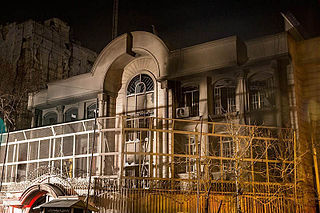
Abdullah Ahmed Abdullah was a high-ranking Egyptian member of al-Qaeda. He has been described as al-Qaeda's most experienced operational planner and was said to be the second-in-command in the organization at the time of his death.
Members of the Iraqi insurgency began taking foreign hostages in Iraq beginning in April 2004. Since then, in a dramatic instance of Islamist kidnapping they have taken captive more than 200 foreigners and thousands of Iraqis; among them, dozens of hostages were killed and others rescued or freed. In 2004, executions of captives were often filmed, and many were beheaded. However, the number of the recorded killings decreased significantly. Many hostages remain missing with no clue as to their whereabouts. The United States Department of State Hostage Working Group was organized by the U.S. Embassy, Baghdad, in the summer of 2004 to monitor foreign hostages in Iraq.
Three Iranian diplomats as well as a reporter for Islamic Republic News Agency (IRNA) were abducted in Lebanon on 4 July 1982. None of them have been seen since. The missing individuals are Ahmad Motevaselian, military attaché for Iran's embassy in Beirut; Seyed Mohsen Mousavi, chargé d'affaires at the embassy; Taghi Rastegar Moghadam, an embassy employee; and Kazem Akhavan, IRNA photojournalist. Motevaselian was also an Islamic Revolutionary Guard Corps (IRGC) member in command of an Iranian expeditionary force in Lebanon.

The Houthi insurgency, also known as the Houthi rebellion, the Sa'dah War, or the Sa'dah conflict, was a military rebellion pitting Zaidi Shia Houthis against the Yemeni military that began in Northern Yemen and has since escalated into a full-scale civil war. The conflict was sparked in 2004 by the government's attempt to arrest Hussein Badreddin al-Houthi, a Zaidi religious leader of the Houthis and a former parliamentarian on whose head the government had placed a $55,000 bounty.

Al-Qaeda in the Arabian Peninsula, or AQAP is a Sunni Islamist militant organization which seeks to overthrow the Yemeni government and establish an Islamic emirate. The group is part of the al-Qaeda network and is primarily active in Yemen and, to a lesser extent, Saudi Arabia. It is considered the most active of al-Qaeda's affiliates that emerged after the weakening of central leadership.

In the years after the September 11, 2001 attack on the World Trade Center in New York City, Yemen became a key site for U.S. intelligence gathering and drone attacks on Al-Qaeda. According to the 2012 U.S. Global Leadership Report, 18% of Yemenis approved of U.S. leadership, with 59% disapproving and 23% uncertain. According to a February 2015 report from the Congressional Research Service, U.S. officials considered Al-Qaeda in the Arab Peninsula the Al-Qaeda affiliate "most likely to attempt transnational attacks against the United States."

The Lashkar-e-Jhangvi, is a Deobandi supremacist, terrorist and militant organisation based in Afghanistan. The organisation operates in Pakistan and Afghanistan and is an offshoot of anti-Shia party Sipah-e-Sahaba Pakistan (SSP). The LeJ was founded by former SSP activists Riaz Basra, Malik Ishaq, Akram Lahori, and Ghulam Rasool Shah.

The Al-Qaeda insurgency in Yemen is an ongoing armed conflict between the Yemeni government, the United States and their allies, and al-Qaeda-affiliated groups in Yemen. It is a part of the Global War on Terror.
International reactions to the Yemeni revolution were not as pronounced as reactions to similar events during the Arab Spring, but a number of governments and organisations made statements on Yemen before and after the departure of longtime President Ali Abdullah Saleh from power in February 2012.
Events in the year 2014 in the Islamic Republic of Iran.

The Houthi takeover in Yemen, also known by the Houthis as the September 21 Revolution, or 2014–15 Yemeni coup d'état, was a popular revolution against Yemeni President Abdrabbuh Mansur Hadi led by the Houthis and their supporters that pushed the Yemeni government from power. It had origins in Houthi-led protests that began the previous month, and escalated when the Houthis stormed the Yemeni capital Sanaa on 21 September 2014, causing the resignation of Prime Minister Mohammed Basindawa, and later the resignation of President Abdrabbuh Mansur Hadi and his ministers on 22 January 2015 after Houthi forces seized the presidential palace, residence, and key military installations, and the formation of a ruling council by Houthi militants on 6 February 2015.

Ahmad Awad bin Mubarak is a Yemeni politician who has been the prime minister of Yemen since 5 February 2024. Before his appointment as Prime Minister, he was the former Foreign Minister of Yemen, and before that he served as Ambassador of Yemen to the United States.
The following lists events that happened during 2014 in Yemen.

The following lists events that happened in 2015 in Yemen.
Ahmad Motevaselian was an Iranian military officer and attaché who was one of four Iranians who disappeared in Lebanon in 1982. During the Iran–Iraq War, he served as a commander in the Islamic Revolutionary Guard Corps and established the 27th Muhammad Rasulullah Division. He played a role in the Second Battle of Khorramshahr and later, as part of a senior diplomatic group of political and military leaders, went to Syria. On 5 July 1982, when the vehicle carrying the diplomats was passing through a checkpoint post on its way to Beirut, it was intercepted by Phalange Party. The car and four passengers, completely disappeared.

The 2015 Sana'a mosque bombings were four suicide attacks targeting two mosques on 20 March 2015 in Sana'a, Yemen.

The Yemeni civil war is an ongoing multilateral civil war that began in late 2014 mainly between the Rashad al-Alimi-led Presidential Leadership Council and the Mahdi al-Mashat-led Supreme Political Council, along with their supporters and allies. Both claim to constitute the official government of Yemen.

Hossein Amir-Abdollahian was an Iranian politician and diplomat who served as foreign minister of Iran from 2021 until his death in 2024. He was the deputy foreign minister for Arab and African Affairs between 2011 and 2016.

The 2016 attack on the Saudi diplomatic missions in Iran was a mob action on 2 January 2016 by protesters demonstrating against the execution of prominent Saudi Arabian Shi'a cleric Sheikh Nimr al-Nimr. Mobs stormed the Saudi embassy in Tehran and the Saudi consulate in Mashhad and ransacked them. The embassy building was set on fire with Molotov cocktails and petrol bombs. During the attacks, the police arrived and dispersed protesters from the embassy premises and extinguished the fire.
The Missionaries of Charity attack in Aden was a mass murder crime committed by unknown gunmen inside a home for older people in Aden, Yemen on 4 March 2016.












